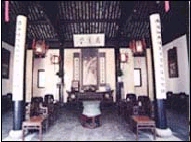 Garden of the Master of the Nets, located on Shiquan Street in Suzhou city with a total area of 0.54 hectares (5400 sqm), is the smallest garden in Suzhou - half the size of Canglang Pavilion and one-tenth the size of Humble Administrator’s Garden. Garden of the Master of the Nets, located on Shiquan Street in Suzhou city with a total area of 0.54 hectares (5400 sqm), is the smallest garden in Suzhou - half the size of Canglang Pavilion and one-tenth the size of Humble Administrator’s Garden.
The garden was laid out during the Song dynasty (960-1279), abandoned, and then restored in the 18th century as part of the residence of a retired official. It was said that the official announced that he’d had enough of bureaucracy and would rather be a fishman. Hence its name.
Being the most exquisite and the best-preserved garden in all old residential gardens in Suzhou, the garden is divided into three parts. The eastern is residential area - originally with side rooms for sedan-chair lackeys, guest reception and living quarters. The central part is the main garden and the western part is an inner garden where a courtyard contains the Dianchun Studio, the master’s study.
Half surrounded by a screen wall and two alleyway side entrances, the front door faces south with hairpin-like door ornaments above it. This type of front door showing owner’s rank at the court has become very rare now. After entering the entrance are sedan-chair hall, grand reception hall and a two-storey tower sitting successively on a north-south axis. Constructed in accordance with the strict regulations of feudalism, they are magnificent buildings with extraordinary furnishing and interior decoration. Every hall has a door or walk-way leading to the main garden.
The main garden, occupying about four fifth of the total area of the garden, is situated northwest of the residential area with a pond in the center. Comparing with the normal architecture in the east residential area, the garden architecture appear more free and was suitable for reading, painting, viewing, resting, sipping tea and holding small banquets.
The pond, covering an area of about 440 sqm, has a tiny arch bridge named Yinjing Bridge (Leading to Quietude Bridge) in its end. The bridge, with a total length of 212cm and width of 29.5cm, is the smallest arch bridge in this garden.
To the west of the main garden is the inner garden, which covers an area of 1 mu (about 667 square meters). Halls, pavilions, springs, plants, and verandas are scattering here and there in this garden, fully embodying the cream of the layout of the Suzhou gardens. Dianchun Studio, a solitary courtyard in this part, was perhaps the fist Chinese garden structure to have found its way to the outside world - Ming Hall, the miniature model of this courtyard was copied in the Metropolitan Museum of Art in New York City in 1981 and the Pompidou Center in Paris in 1982.
The most striking feature of Garden of the Master of the Nets is its use of space. Small as its size is, the scale of the building is large, but nothing appears cramped. Based on illusion, the garden is full of change, capturing the effect of boundlessness, and achieving a unity of part and whole. The Master-of-Nets Garden serves to illustrate how the few surpasses the many and the small exceeds the large.
|